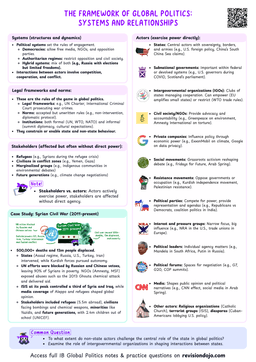Types of Conflict

Understanding Conflict in Global Politics
Conflict
Conflict is a central theme in global politics, encompassing a wide range of disputes and tensions that arise between individuals, groups, and states. It is essential to understand the different types of conflict to analyze their causes, dynamics, and potential resolutions.
Key Types of Conflict
- Interstate Conflict
- Intrastate Conflict
- Transnational Conflict
- Non-State Conflict
- Ideological Conflict
- Resource-Based Conflict
- Ethnic and Religious Conflict
Types of Conflict as Neighbourhood Disputes
- Interstate Conflict
- → Like two houses (countries) fighting over a fence line.
- (e.g., Russia vs Ukraine)
- Intrastate Conflict
- → A family fighting inside one house, civil war within a single country.
- (e.g., Syrian Civil War)
- Transnational Conflict
- → A group from one house goes into others’ homes to cause trouble.
- (e.g., ISIS operating across borders)
- Non-State Conflict
- → Gangs (non-state actors) in the neighborhood causing clashes with each other or the police.
- (e.g., terrorist groups vs militias)
- Ideological Conflict
- → Neighbors clashing over values, like one group wanting modern rules, another wanting tradition.
- (e.g., Cold War: capitalism vs communism)
- Resource-Based Conflict
- → Houses fighting over shared water pipes or parking spaces, scarce resources.
- (e.g., Nile River disputes, oil in South Sudan)
- Ethnic and Religious Conflict
- → Different cultural or faith-based families in the neighbourhood struggling to live together peacefully.
- (e.g., Rohingya crisis, Israel–Palestine)
1. Interstate Conflict
- Interstate conflict occurs between sovereign states and often involves military engagements.
- These conflicts are typically driven by territorial disputes, power struggles, or geopolitical interests.
- The India-Pakistan conflict over Kashmir is a classic example of interstate conflict, rooted in territorial claims and historical animosities.

2. Intrastate Conflict
- Intrastate conflict, also known as civil war, occurs within a single state.
- These conflicts often involve government forces and non-state actors, such as rebels or insurgent groups.
- Causes:
- Political oppression
- Economic inequality
- Ethnic or religious tensions
- The Syrian Civil War: A complex conflict involving multiple factions, including the Syrian government, rebel groups, and international actors.
- The Rwandan Genocide: Driven by ethnic tensions between the Hutu and Tutsi populations.

3. Transnational Conflict
- Transnational conflict involves actors or issues that cross national borders.
- These conflicts often include non-state actors and are characterized by their global impact.
- Terrorism: Groups like Al-Qaeda and ISIS operate across multiple countries, challenging state sovereignty.
- Drug Trafficking: Cartels in Latin America create instability across the region.

4. Non-State Conflict
- Non-state conflict involves armed groups that are not officially affiliated with any government.
- These conflicts can occur within or across state borders.
- Boko Haram in Nigeria: A militant group fighting against the Nigerian government and spreading terror in the region.
- FARC in Colombia: A guerrilla group that engaged in a decades-long conflict with the Colombian state.


